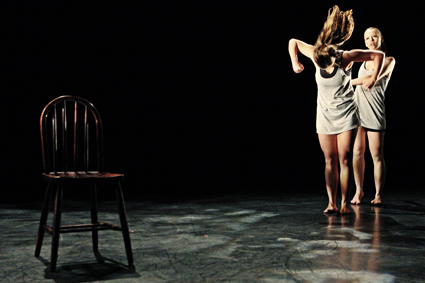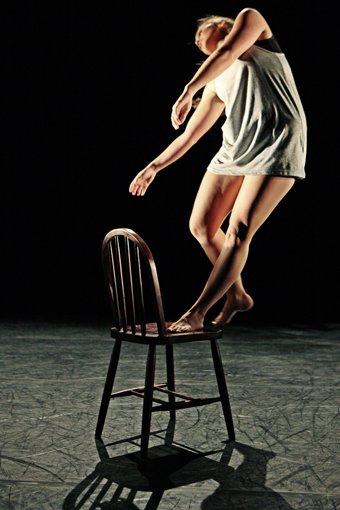True calling: the good news & the bad
jodie mcneilly: pressures on tertiary dance education

Sarah Banks, Kiralee Mulley, choreographer Julia Woolbank, students in Dance Studies, UNSW School of the Arts and Media
photo Prudence Upton
Sarah Banks, Kiralee Mulley, choreographer Julia Woolbank, students in Dance Studies, UNSW School of the Arts and Media
AUSTRALIAN UNIVERSITIES, TAFES AND DUAL SECTOR INSTITUTIONS SUFFER ONGOING FUNDING CUTS FROM FEDERAL AND STATE GOVERNMENTS THAT RESULT IN STAFF REDUNDANCIES, WORKLOAD INCREASES, PROGRAM RESTRUCTURES, DEGREE DEVOLUTION, RESOURCE REALLOCATION, REDUCTION OF FACE TO FACE TEACHING HOURS AND, IN SOME INSTANCES, THE CLOSURE OF CAMPUSES.
This is happening across several disciplines, but the pain is mostly felt in the humanities and creative arts. With government austerity measures clearly impacting adversely upon our education policies, we have to ask: how will our dance programs continue to survive in the tertiary context?
During the early part of the 20th century, Bertrand Russell was alert to the crisis of the university. Despite his criticisms of the class-determined nature of these learning institutions as elite-only establishments, he became more critical about the prioritising of the technical and utilitarian over the pursuit of knowledge and wisdom. This slowly became the guiding ethos of the university and heralded a new sense of the vocational: the becoming of ‘the paid professional,’ where labour-based skills trained one to be a mere cog in the wheel of industry. Vocation was no longer understood to be the creative production of self in the pursuit of a true calling.
Vocation as learning a profession for paid labour is the conception operating in universities today. Dance education can be vocational in this sense, but for the most part, a dancer chooses to perform, choreograph, develop a studio practice or research dance in the higher sense of a calling. Tertiary dance in Australia has done well to cater for both these senses of vocation, and some institutions continue to support this integrated learning, despite the swath of cuts and course restructures. In the wake of devastating changes to related creative arts disciplines—like the ANU’s Music School, whose elite performance training course has become unrecognisable, with almost half its staff losing or having to reapply for their jobs, and the closure of art-related degree courses within Victorian TAFES—leading academics are unsure about the future of dance and the shape of its programs in the tertiary sector.
In speaking about their experiences of recent funding cuts and/or degree restructures, academics mostly provide positive stories. Nannette Hassall, Senior Lecturer at Edith Cowan University’s Western Australian Academy of Performing Arts (WAAPA) boasts of a healthy undergraduate degree model where students can undertake technique with a strong academic focus and be engaged with industry through the performance stream and international exchange program. Despite the fact that dance is considered expensive compared to other disciplines (an economically irrational view) the program at WAAPA has survived recent review. Students can be happy about the continued balance between studio practice, academic engagement and performance training.
Dr Sally Gardner, Lecturer in the School of Communication and Creative Arts at Deakin University, is happy to announce the addition of a new second studio, confirming expansion rather than contraction. However, staff are exhausted from a workload model that “does not recognise hours of teaching but only numbers of students taught.” They juggle teaching, research, publishing, performance production and “ever increasing administrative duties.” When workloads become untenable because of unreasonable expectations, the joy of teaching is extinguished by modes of labour alienation. No matter how healthy a course presents itself, a crisis may only be averted by bettering the conditions of staff.
Associate Professor Jenny Kinder, Undergraduate Coordinator at VCA, has only good news following the recent development of the college’s new Bachelor of Fine Arts degree. Dancers will continue to be cultivated into the industry through “intensive studio-based practice and quality performance experience.” The new degree structure will allow students to either specialise in dance through the BFA (Bachelor of Fine Arts) or take on a range of electives from other artistic disciplines that can lead to postgraduate studies in teaching at the University of Melbourne. This model echoes dance program structures within the US where most colleges and universities offer a BFA to specialise in elite performance.
The WAAPA program has a strong performance and production stream. Staff strategically create links with industry and the wider community so that students are exposed to a diversity of practices from local, interstate and international artists. Although adding to an untenable workload, a lot of strategic producing enriches the dance program at Deakin. Gardner says that to cover the shortfall in financial support from the university, the staff has “become active in making partnerships with dance organisations such as Dancehouse, and with local government arts offices.” “In-kind payment such as use of studio space” is offered to visiting and local artists to ensure students continue to have a rich learning experience. The appointment of casual and adjunct staff is important, but when they begin to replace permanent staff, the weight of administrative duties and strategic planning lands heavily in the lap of the few—and sometimes just the one.

Sarah Banks, choreographer Julia Woolbank, students in Dance Studies, UNSW School of the Arts and Media
photo Prudence Upton
Sarah Banks, choreographer Julia Woolbank, students in Dance Studies, UNSW School of the Arts and Media
Dr Erin Brannigan, Lecturer in the University of NSW’s School of the Arts & Media, has preserved strong links with industry through artist residencies in the associated Io Myers Studio. The once audition-based, dance teacher training degree has undergone a radical restructure to embrace an academically oriented Dance Studies major within a BA, and is modelled on the school’s Performance Studies program. Studio practice remains a central part of the offerings, but with a focus on somatic practices (rather than traditional techniques) as modes of embodied training for contemporary performance. The new structure helps to “find ways to open up the arts” and share structurally sound interdisciplinary relationships.
Dance Studies as a discipline legitimates corporeal practices as valued epistemes in knowledge production. The role of dance and movement in the development of conceptual thinking—and our species being—broadens our ideas of dance and choreography. Taken as genuine approaches to understanding the world, and not restricted to virtuosity and technique, dance becomes accessible to those who are interested. The dance program headed by Dr Pauline Manley at Macquarie University has this in mind, and takes it further by providing technique classes for the untrained alongside the trained. This model uniquely leans towards the idea of vocation as a calling, rather than the path to paid professionalism (not to say a profession isn’t possible).
Hassall believes the recent cuts and shuffling mark a “critical moment” for tertiary dance. She has been in academia for a long time, saw where academic dance “came from” and “can see where it could rapidly be returning to”: the private institution. Brannigan suggests that this could be the alternative for those desiring technique- led courses, especially in NSW, which has (since the demise of University of Western Sydney courses ) lacked a well-rounded audition-based program like WAAPA, QUT, VCA or Deakin’s. Dancers wanting intensive technique head interstate, overseas or pay for training in private studios and colleges like the Wesley Institute and the Australian College of Physical Education. The future of contemporary dance training (mostly associated with a degree structure) could mean a return to the private studio, separating practice from critical thinking.
Professional training in a private studio or college is an expensive option; at least university permits students to defer this expense. There is a responsibility on the part of our government to subsidise the creative arts, not to reorient responsibility back to private institutions. Gardner points out that “Compared to 25 years ago when the arts warranted attention and action” there is now little “discussion of cultural policy.” In the dance sector it occurs even less. Our federal and state agencies need to begin valuing and re-evaluating the nation’s attitude towards cultural cultivation and the training of our next generation of artists, or we will end up with what Hassall projects as “the population we deserve.”
Dr Elizabeth Dempster, Senior Lecturer at Victoria University, sees universities as responsible for the crisis in the creative arts. In 2009 the once thriving undergraduate Performance Studies major with studio practice folded to one-third of its size. Dempster says now, “third year students are at the same level as they were by the end of first year under the old program.” Universities have “failed to engage and respond respectively to art forms, and have been derelict in their duties.” Programs are being strategically designed to collapse multiple art forms into single degrees, like VU’s current Bachelor of Creative Industries, and eventually suffer decimation through lack of financing and resources by the so-called visionary hands that build them.
There is good news and bad in these stories, stories that are not new, nor isolated to dance. The academic world is in crisis; it suffers along with other industries as the movement of global capital becomes far too erratic for liberal western democracies to cope with. Dance education within tertiary institutions is safe, at least for now. It survives under the tireless, creative strain of our resilient academics who—as romantic or religious as the notion may seem—continue to support dance in the sense of a true calling.
RealTime issue #110 Aug-Sept 2012 pg. 4






